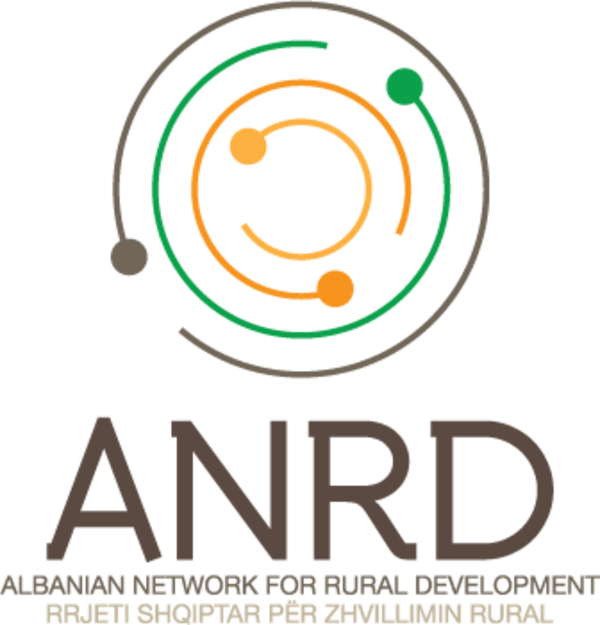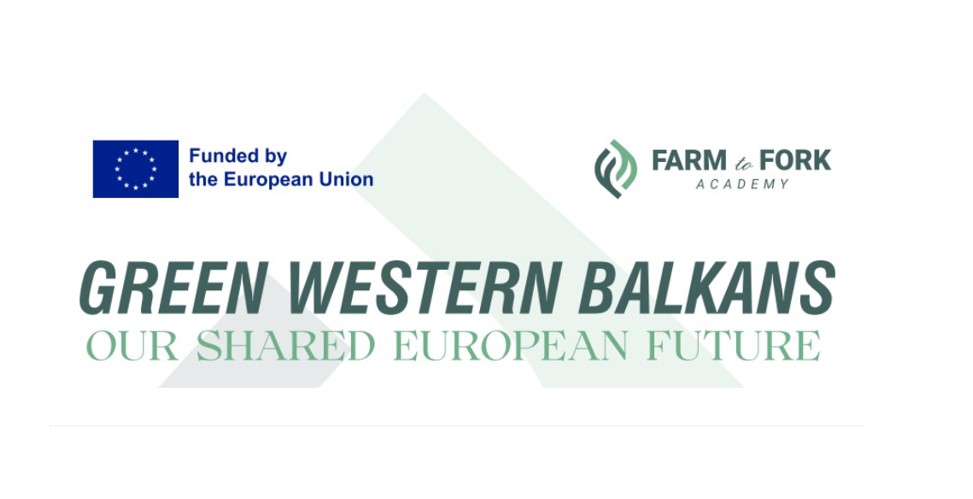*Scroll down for the Call for Applications for the Farm to Fork Academy Fund
| Project title | Farm to Fork Academy for Green Western Balkans – Our shared European future |
| Funded by | European Commission Support to Regional thematic networks of Civil Society Organizations EuropeAid/174154/DH/ACT/MultiLot 3: Green and Digital Transition |
| Project region | WB-6 Countries and Croatia |
| Lead organization | Albanian Network for Rural Development |
| Duration | 16.01.2023 – 15.01.2027 |
| Budget | 1,442,183.16 Euro |
The regional project ‘Farm to Fork Academy for Green Western Balkans – Our shared European future’ involves the following countries: Albania, Bosnia and Herzegovina, Kosovo*, Montenegro, North Macedonia, Serbia and Croatia. The Farm to Fork Academy Project – is jointly implemented by the family of National Rural Development Networks (NRDNs) in the six Western Balkan countries (WB-6) and Croatia and their regional cooperation platform Balkan Network for Rural Development (BRDN).
The project focuses on the implementation of the EU integration and approximation process in the WB countries in the agricultural and rural development sector by advancing the green and just transition in the region through the contribution of civil society actors.
It will do so by stimulating a better environment for CSOs and CSOs Networks and other rural stakeholders to proactively contribute in addressing societal challenges related to climate changes and biodiversity losses through building competencies able to assist farming and rural communities toward green and just transition across the region, whereas are able to sustain participatory and bottom-up consultation and constructive policy dialogue to accelerate the reforming process in approximating with EU’s common agricultural policy (CAP), in particular alignment with the EU Green Deal and F2F Strategy.
For more information, please read the fact sheet of the project Fact Sheet_Farm To Fork Academy project.
Open Call for Applications: Support to Civil Society Organizations through the Farm to Fork Academy Fund

The Farm to Fork Academy for Green Western Balkans project supports civil society actors in the Western Balkans and Croatia in advancing the green and just transition aligned with the EU Green Deal and the Farm to Fork (F2F) Strategy. This fund aims to enhance civil society’s role in the EU integration process, particularly in sustainable agriculture and rural development.
Objectives:
- Overall Goal: Strengthen civil society’s contribution to EU integration, focusing on sustainable food systems and climate change.
- Specific Goal: Promote innovative, green, and inclusive solutions for sustainable livelihoods, addressing climate change and biodiversity loss.
Themes for Proposals
- Sustainable farming and agriculture practices, rural development, and food production
- Environmental protection and biodiversity conservation
- Climate change mitigation and adaptation
Eligibility Criteria:
- F2F Academy Fund Line 1: Local Action Groups (LAGs) registered as CSOs with at least six months of relevant experience.
- F2F Academy Fund Line 2: Grassroots CSOs and membership-based organizations (e.g., farmers associations, cooperatives) with at least two years of relevant experience.
Grant Details:
- Grant Amount: EUR 3,000 – EUR 5,000 (100% of eligible costs covered).
- Fund Allocation: EUR 120,000 per fund line, with a budget of EUR 20,000 per country.Project Duration:
Minimum 6 months, maximum 9 months.
Place of Implementation:
Albania, Bosnia and Herzegovina, Kosovo, Montenegro, North Macedonia, and Serbia.
Submission Deadline:
Applications must be submitted by 25 April 2025, 23:59, to [email protected].
Required Documents:
- Application Package
- Supporting Documents
For more information, please refer to the full application package.
English
Albania | Link to Local Call
Bosnia and Herzegovina | Link to Local Call
Kosovo | Link to Local Call
Montenegro | Link to Local Call
North Macedonia | Link to Local Call
Serbia | Link to Local Call
FREQUENTLY ASKED QUESTIONS | FAQ
Is it possible within the project framework to procure a small greenhouse intended for growing flowers and herbs? This initiative would allow for the inclusion of a larger number of unemployed women, given that women are most commonly involved in this field.
- Yes, it is possible to procure a small greenhouse under the project framework, provided that it aligns with the project’s goals and objectives. The inclusion of unemployed women in such an initiative would be in line with empowering the target group, as women are often the primary participants in such activities.
Is there an option within the project to purchase equipment, specifically machines, cultivators, etc., for individual households?
- Yes, purchasing equipment such as machines and cultivators is allowed. However, the equipment must be used for community purposes. The intention should be to benefit the wider community, not just individual households. Furthermore, the equipment must be financially accounted for and reported within the organization’s records, maintaining transparency and proper financial oversight.
Is it possible for, for example, four different organizations to submit a joint application, where each organization submits its own proposal, but together they form one larger project in which each organization implements a different component of the activities?
- No, joint applications or partnerships between organizations are not allowed under this project. While the idea may seem feasible on paper, such an approach introduces risks in terms of project coordination and security. The project’s rules require that each proposal be submitted by a single organization, and all activities must be cohesive and aligned under one applicant organization.
When procuring equipment for demonstration farms, must the equipment be registered under the organization, or can it be utilized within a household?
- The equipment should be procured and registered under the organization. However, once purchased, the organization can later donate the equipment to a household through a donation order. Despite this, the equipment must be financially accounted for and reported within the organization’s records, maintaining transparency and proper financial oversight.
What happens to the budget if we decide not to buy vehicles?
- The 40% allocated for vehicle-related expenses in the budget is not mandatory. This figure is indicative and represents the maximum allowable amount for such expenditures. You are free to reallocate the remaining budget towards other activities, as long as they align with the project’s objectives and guidelines. The funds can be utilized for other project components as needed.
Are per diems allowed for the individuals involved in the project during field monitoring visits?
- Yes, they are allocated under the section: 2.1 Local Transportation.
Is it possible to pay the salaries of hired personnel (budget group Human Resources) through the entrepreneurial agency of the hired person?
- Yes, it is possible, provided that the payment complies with local tax legislation and labor laws. The agency must issue proper documentation (e.g., invoice) and the arrangement must be financially justified and transparent. Clear records must be maintained for auditing purposes, and the service must reflect actual work performed in line with the project objectives.
Can the start of implementation be negotiated at a later date, and not immediately after the selection of the grant winner?
- The start date of implementation is expected to follow shortly after the signing of the grant agreement. However, a short delay may be discussed with the contracting authority if justified (e.g., administrative or logistical reasons). Any changes must be agreed upon and formally approved before implementation begins.
Is there a limit to the type of equipment that can be purchased?
- Yes, there are limitations. While the purchase of equipment is allowed, it must be clearly justified as essential for achieving the objectives of the proposed project. However, the procurement of office-related equipment such as printers, computers, mobile phones, and similar items is generally not eligible unless it is specifically required for the implementation of project activities and properly justified. All equipment must be cost-effective, necessary, and in full compliance with the project’s financial guidelines.
Can an activity in the project be a study visit? If possible, can it also be in other countries of the Western Balkans (e.g., an organization from Serbia to organize a study visit to Montenegro)?
- Yes, study visits are eligible activities, as long as they contribute to the objectives of the project and are well-justified in the application. Study visits can take place in other Western Balkan countries. Cross-border learning and exchange of good practices are encouraged, especially if they strengthen regional cooperation and capacity building.
Can an association purchase equipment that exceeds the maximum value allowed by this Call for Proposals, and report only the portion of the cost that is covered (e.g., up to 40% of the total project value) to the granting authority?
- Yes, this is possible. An association may purchase equipment at a higher value than the ceiling defined in the call (e.g., the 40% limit for equipment), as long as only the eligible portion—in this case, up to 40% of the total project budget—is reported to and reimbursed by the granting authority. The remaining cost must be covered by the association from its own resources. This procedure must be clearly documented, and the full cost of the equipment should be presented with supporting invoices and a breakdown showing the co-financed amount.
If an organization is currently implementing another project, is it allowed to use the €5,000 grant from this Call as co-financing to support the implementation of that ongoing project?
- There are no limits regarding co-financing. However, it is essential that expenses are clearly separated and documented in such a way as to avoid any form of double funding for the same activities or budget lines.
Additionally, the objectives and results to be achieved with the support of this Call must be clearly defined, in order to ensure that the impact of the funding is measurable and traceable.

